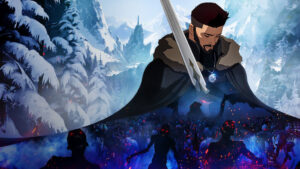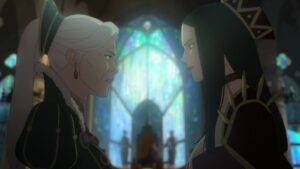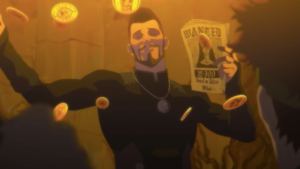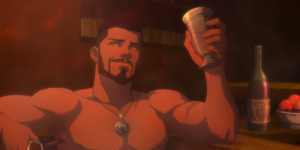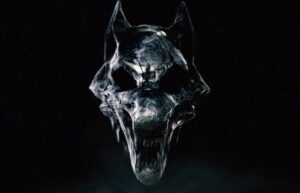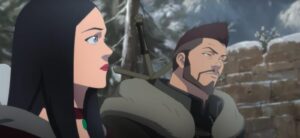Let’s get this out of the way upfront: the first trailer for Netflix’s upcoming live-action reimagining of the classic 1998 anime Cowboy Bebop is wildly entertaining regardless of whether or not you’ve watched the original series. If I knew nothing about the plot beyond what the trailer told me, I’d still likely feel compelled to check this out based solely on the colorful visuals, cool blend of sleek science-fiction and gritty film-noir aesthetics, zany character designs, and the soaring jazz score by Yoko Kanno. But as good as Cowboy Bebop looks, I probably wouldn’t have reviewed the trailer had I not been able to finish binge-watching the original anime just the night before last.

Most of the time, if I’m not already ingrained in the fandom of any particular franchise I choose to cover, I’ll do my best to research that franchise’s lore and mythology before writing about it. To cite an example off the top of my head, I’ve never read The Witcher stories nor played the games, but I’ve written extensively about material from both while covering the Netflix adaptation. But in the case of Cowboy Bebop, I felt very strongly that I needed to absorb the anime’s themes before I could properly pass judgment on its successor.
That’s not to say that watching the original anime is essential to understanding or appreciating the Netflix series (although…well, more on that in a moment), but I’m glad I did. Because for all its witty humor and cute corgis, the original Cowboy Bebop is also a deeply melancholy series that examines how we can all too easily become defined by the events of our past, or alternatively choose to find the strength within ourselves to define our future. The anime builds off that core concept to explore a wide spectrum of human responses to trauma, regret, and the consequences of our own actions, through a cast of four main characters who are all stuck at pivotal points in their lives.
That was something I started to become aware of by the end of the first episode, and it drove me to finish the anime just in time for the release of this trailer, so that I could come into this review knowing what Cowboy Bebop is at its core and what Netflix’s reimagining has to be, and not just discussing the various references to the original series that I might have been able to catch through research. And in the process, I’ve discovered a great new show, and become invested in the anime’s vibrant world and complex characters (especially Faye Valentine – I knew I was going to love Faye Valentine the moment she walked onscreen, but I love Faye Valentine).
And yes, of course I know that I’m over two decades late to the party for the original Cowboy Bebop, but all of us – those who’ve been fans since 1998, and those who’ve joined the fandom in the years since – will get to enjoy Netflix’s reimagining of the anime together. Now you may have noticed by this point that I’ve used the word “reimagining” a lot to describe this live-action iteration of Cowboy Bebop, and that’s because details are still kind of hazy about what Netflix intends for this to be. Is it a remake? Some kind of retelling? A total reboot?

None of those options seem particularly appealing, which is why I’m using the word “reimagining” out of a hope that Netflix’s series aspires at least to be more than a carbon-copy of the original anime. In a world – or rather an entire solar system – as diverse and expansive as that in which the largely stand-alone stories of Cowboy Bebop take place, there’s really no excuse for the Netflix series not to try and do its own thing. And yet this trailer indicates that Netflix will be recreating numerous iconic scenes, even entire episodes and story arcs, from the anime.
In that spirit, it seems that Netflix has aimed for as strict an adherence to the original character designs of Cowboy Bebop as live-action will allow. There’s spot-on casting, and then there’s John Cho as Spike Spiegel. He’s maybe slightly older than how I envisioned Spike in the anime, but Cho has all of Spike’s physicality, and he’s rocking the bounty hunter’s snazzy blue suit. Spike is an enigmatic figure who lingers in the galaxy searching for purpose but remains tethered to his tragic past by love and anger, and I can’t wait to see what Cho does with a quiet and pensive character like that.
If you’re getting some Mandalorian vibes from Spike Spiegel and the space western setting of the series in general, well, so is Netflix. And I think it’s pretty obvious why this trailer and other promotional material for the series has massively played up the importance of Spike’s sidekick Ein, an extremely intelligent corgi who is absolutely going to be Cowboy Bebop‘s answer to Baby Yoda. The fact that Baby Yoda’s popularity was a complete shock to everyone, including Disney, is something that other studios seem to have forgotten in their rush to find and subsequently overpromote their own adorable nonverbal sidekick characters.
I’m tempted to draw a similar link between the reinvention of Faye Valentine as a rough-and-tumble brawler with a soft spot for dogs and The Mandalorian‘s Cara Dune, although I truly hope Daniella Pineda isn’t channeling any part of Gina Carano’s unmemorable performance into her portrayal of Valentine, my favorite character in the original Cowboy Bebop crew. Valentine is a great bounty hunter, but it’s the daily battle she wages inside her head with the remnants of the person she used to be that really had me rooting for her to succeed. So much of her story hinges on the quiet moments when she’s confronting her past, and I hope that Pineda can sell those scenes as well as her action sequences.
Sadly, the trailer doesn’t give us so much as a glimpse of my second-favorite Cowboy Bebop character, Radical Edward, the energetic young hacker who joins the team almost on a whim and lights up the whole show with their vivacious personality. But we do see plenty of Mustafa Shakir as Jet Black, looking very dapper in what are presumably flashbacks to his early days as a police officer on Ganymede before swapping out his suit and fedora for the more practical gear of a bounty hunter. Jet is the only member of the Bebop team who actively longs to return to his old way of life, and the way that the anime slowly disabuses him of that nostalgia is heart-wrenching to watch.

But personally, I hope that the Netflix series has new ideas for how to evolve the characters. They’re clearly sticking with the core elements of Spike’s backstory, as evidenced by the repeated appearances of Spike’s arch-nemesis Vicious in the trailer, but if Netflix plans for Cowboy Bebop to be a long-running series with franchise potential I assume that either the narrative won’t be structured exclusively around Spike and Vicious’ long-running conflict, or the showrunners have an idea for how to send their storyline down a different route than the original anime, which ended conclusively after just twenty-six episodes.
Speaking solely for myself here, I know that what I don’t want from this series is something that feels beholden to the anime by only revisiting areas we’ve already seen and retelling stories we already know, instead of honoring the adventurous spirit of the original series by exploring beyond its boundaries. This trailer is full of so much energy and potential, I’d hate to see that go to waste.
Trailer Rating: 8.5/10









